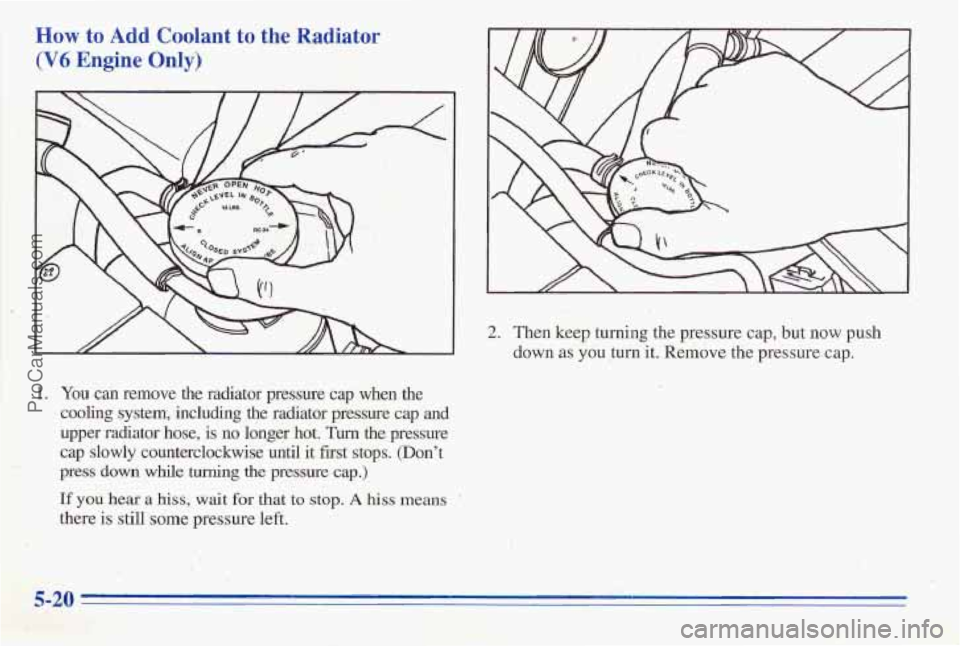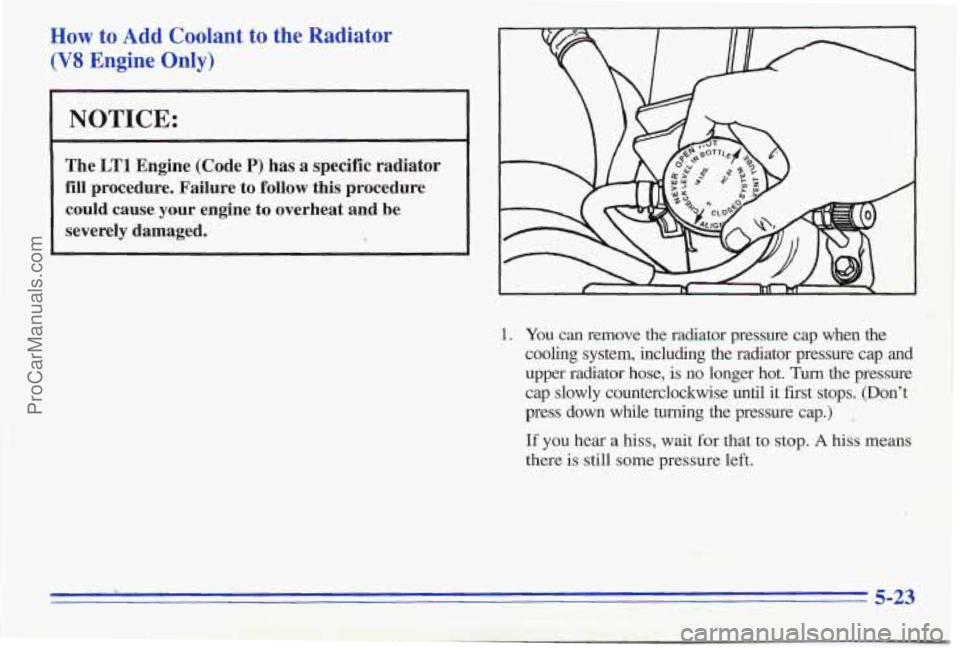radiator cap PONTIAC FIREBIRD 1996 Owners Manual
[x] Cancel search | Manufacturer: PONTIAC, Model Year: 1996, Model line: FIREBIRD, Model: PONTIAC FIREBIRD 1996Pages: 386, PDF Size: 19.18 MB
Page 214 of 386

When you decide it’s safe to lift the hood, here’s what
you’ 11 see: When
you decide
it’s safe to lift the hood, here’s what
you’ll see:
V8 Engine
1. Coolant Recovery Tank
2. Radiator Pressure Cap
3. Electric Engine Fan
V6 Engine
1. ’Coolant Recovery Tank
2. Radiator Pressure Cap
3. Electric Engine Fan
ProCarManuals.com
Page 215 of 386

An electric fan under the hood can start up even
when the engine
is not running and can injure
you. Keep hands, clothing
and tools away from
any underhood electric fan,
If the coolant inside the coolant recovery tank is boiling,
don’t do anything
else until it cools down.
When it is cool, remove the coolant recovery tank cap
and
look at the dipstick.
The coolant level should be at FULL COLD. If it
isn’t, you may have a leak in the radiator hoses, heater
hoses, radiator, water pump or somewhere else in
the
cooling system.
5-16
ProCarManuals.com
Page 218 of 386

Steam and scalding liquids from a hot cooling
system can blow out and burn you badly. They
are under pressure, and if you turn the radiator
pressure cap
-- even a little -- they can come out
at high speed. Never turn the cap when the
cooling system, including -the radiator pressure
cap,
is hot. Wait for the cooling system and
radiator pressure cap to cool
if you ever have to
turn the pressure ca,p.
5-19
ProCarManuals.com
Page 219 of 386

HOW to Add Coolant to the Radiator
i'l (V6 Engine Only)
2. Then keep turning the pressure cap, but now push
down
as you turn it. Remove the pressure cap.
1. You can remove the rachator pressure cap when the
cooling system, including ,&e radiator pressure cap Bnd
upper radiator hose,
is no longer hot. Turn the pressure
cap slowly counterclockwise until
it first stops. (Don't
press down while turning the pressure cap.)
If you hear a hiss, wait for that to stop. A hiss means '
there is still some pressure left.
5-20
ProCarManuals.com
Page 220 of 386

3. Fill the radiator with the proper mix, up to the base
of the filler neck.
4.
5.
Then fill the coolant recovery tank to FULL COLD.
Put the cap back on the coolant recovery tank, but
leave the radiator pressure cap
off.
ProCarManuals.com
Page 221 of 386

6. Start the engine and let it run until you can feel the
upper radiator hose getting hot. Watch out for the
engine
fan.
filler neck may be lower. If the level is lower, add
more
of the proper mix through the filler neck until
the level reaches the base
of the filler neck.
7. By this time the coolant level inside the radiator
8. Then replace the pressure cap. At any time during
this procedure if coolant begins to flow out
of the
filler neck, reinstall the pressure cap. Be sure the
arrows on the pressure cap line up like this.
, 'I I
5-22
ProCarManuals.com
Page 222 of 386

How to Add Coolant to the Radiator
(V8 Engine Only)
NOTICE:
The LTl Engine (Code P) has a specific radiator
fill procedure. Failure to follow this procedure
could cause your engine to overheat and be
severely damaged.
<
I
1. You can remove the radiator pressure cap when the
cooling system, including the radiator pressure cap and upper radiator hose, is
no longer hot. Turn the pressure
cap slowly counterclockwise until it first stops. (Don’t
press down while turning the pressure cap.)
.
If you hear a hiss, wait for that to stop. A hiss means
there is still some pressure left.
ProCarManuals.com
Page 269 of 386

NOTICE:
If you use an improper coolant mix, your engine
could overheat and be badly damaged. The
repair cos’t wouldn’t be covered by your
warranty.
Too much water in the mix can freeze
and crack the engine, radiator, heater core and
other parts.
If you have to add coolant more than four times a year,
have your dealer check your cooling system.
NOTICE:
If you use the proper coolant, you don’t have to
add extra inhibitors or additives which claim to
improve the system. These
can be harmful.
Checking Coolant
When your engine is cold, check the dipstick on the cap
of the coolant recovery tank. The coolant level should
be at COLD, or a little higher. When your engine is
warm, the level on the dipstick should be up to HOT, or
a little higher.
6-28
ProCarManuals.com
Page 270 of 386

LOW
COOLANT
If this light comes on,
it means you’re low on
engine coolant.
.. 5.7L LT1 Engine
Adding Coolant to the Recovery Tank
j,
If you need more coolant, add the proper mix at the
emban& recovery tank, but only when your engine is
cool. If the tank is very low or empty, also add coolant
to the radiator. See “Engine Overheating” in
the Index
for
information.
LAUTION:
”urning the radiator pressure cap when the
engine and radiator are hot can allow steam and
scalding liquids to blow out and burn
you badly-
Never turn the pressure cap -- even a
little -- when the engine and radiator are hot.
Add coolant mix at the recovery tank, but be careful not
to spill it.
I
You can be burned if you spill coolant on hot
engine parts.
Coolant contains ethylene glycol,
and it will burn if the engine parts are hot
enough. Don’t spill coolant on
a hot engine.
ProCarManuals.com
Page 271 of 386

Radiator Precsure Cap (All Engines)
NOTICE:
Your radiator cap is an 18 psi (124 kPa)
pressure-type cap and must be tightly installed to
prevent coolant loss and possible engine damage
from overheating. Be sure the arrows on the cap
line up with the overflow tube on the radiator
filler neck.
When you replace your radiator pressure cap, an AC@
cap is recommended.
Thermostat
Engine coolant temperature is controlled by a thermostat
in the engine coolant system.
The thermostat stops the
flow of coolant through the radiator until the coolant
reaches
a preset temperature.
When
you replace your thermostat, an AC@ thermostat
is recommended.
Power Steering Fluid
3800 L36 Engine
When to Check Power Steering Fluid
It is not necessary to regularly check power steering fluid
unless you suspect there
is a leak in the system or you hear
an unusual noise. A fluid loss in this system could indicate
a problem. Have the system inspected and repaired.
6-30
ProCarManuals.com